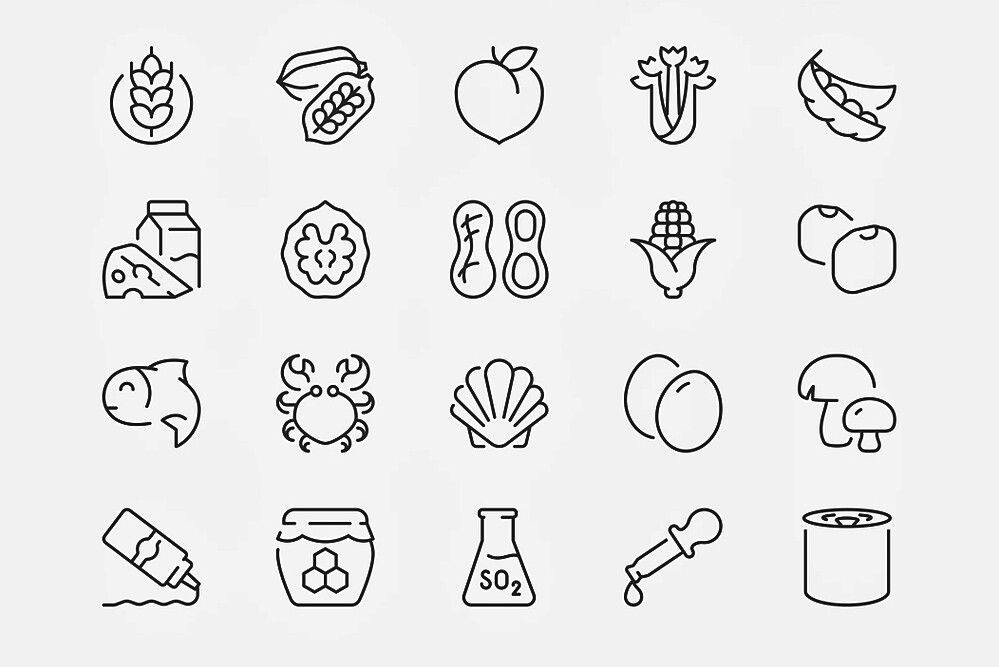There are a total of 14 allergens that belong to the so-called main allergen groups and must be labelled. You can get the whole list here.
What are allergens?
Allergens are substances that can trigger allergic reactions in allergy sufferers. There are a total of 14 allergens which are part of the so-called main allergen groups and which, according to a new EU Food Information Regulation (LMIV) from 2014, must be identified in dishes (e.g. in restaurants).
For the sake of simplicity, the various allergens are marked with assigned letters, but they must also be mentioned by name. How exactly the labelling is implemented is up to the respective company.
The rules of the LMIV are strict, because a strong allergy to certain substances can also have dangerous consequences. The symptoms of consuming one of the allergens range from slight discomfort to allergic shock, which can become life-threatening.
Allergen labelling: Which allergens are there?
Here is the list of the 14 major allergen groups that can cause symptoms in food allergies:
- A: Gluten/products, e.g. any cereal containing gluten such as wheat, bread, pastries, sauces, sausages or desserts
- B: Crustaceans/products, e.g. soups, sauces or fish substitutes such as sashimi
- C: Eggs/products such as bakery products, cakes, sauces, desserts or dressings
- D: Fish/products, e.g. sauces, soups, sausages or spreads
- E: Peanuts/peanut products, e.g. margarine, bread, cake or muesli
- Q: Soya/products, e.g. sweets, mayonnaise, marinades or coffee whiteners
- G: Milk/products (lactose), e.g. cakes, sausages, croquettes and chips, desserts or cocoa
- H: Nuts/nut products, e.g. bread, cakes, pastries, yoghurt, cheese or muesli bars
- L: Celery/products, e.g. spiced bread, sausages, broths, ready meals, chips or meat products
- M: Mustard/products, e.g. soups, sauces, dressings, cheese, ketchup or mayonnaise
- N: Sesame seeds/products, e.g. pastry, bread, humus, salad, marinades or desserts
- O: Sulphur dioxide/sulphites, e.g. bread, muesli, sauerkraut, fruit juices or chips
- P: Lupin/products, e.g. bread, pastry, noodles, pizza or snacks
- R: Molluscs/products, e.g. soups, sauces, marinades or delicatessen salads
In fact, theoretically any protein can become an allergen. Normally these are harmless and do not cause any reaction in humans. In the case of allergies, however, the immune system reacts excessively strongly against these foreign substances, which can lead to symptoms such as reddening of the skin, burning and watery eyes, sneezing attacks and colds.
Allergy – a question of age?
Adults and children often differ in allergies. Children are more likely to have intolerances to milk or protein, adults are more likely to react to fruit, nuts or fish. It is interesting to note that allergies that occur in children tend to disappear by adulthood. On the other hand, other related diseases, such as asthma, can occur. Experts call this an “atopic march”, which can have the following causes:
- Lifestyle (diet, stress, smoking)
- Environmental influences (e.g. air quality)
- Genetic factors
If an allergy only occurs in adulthood, it is less likely to disappear on its own. The older you are, the less chance you have of getting rid of the allergy without treatment.

